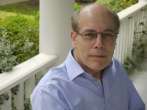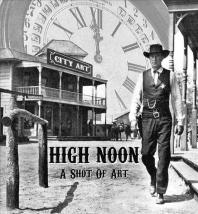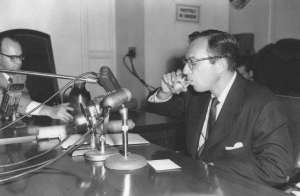 Glenn Frankel worked for the “Washington Post” for three decades, winning a Pulitzer Prize in the process. Since retiring from the day-to-day news business, he’s kept an eye on social and political issues, but he’s explored them in the context of Hollywood. His last book, “The Searchers: The Making of an American Legend,” was a best-seller and received strong critical reviews. His latest book, “High Noon: The Hollywood Blacklist and the Making of an American Classic,” explores Hollywood and the United States in the middle of the 20th century. Published in the Houston Chronicle on February 26, 2017.
Glenn Frankel worked for the “Washington Post” for three decades, winning a Pulitzer Prize in the process. Since retiring from the day-to-day news business, he’s kept an eye on social and political issues, but he’s explored them in the context of Hollywood. His last book, “The Searchers: The Making of an American Legend,” was a best-seller and received strong critical reviews. His latest book, “High Noon: The Hollywood Blacklist and the Making of an American Classic,” explores Hollywood and the United States in the middle of the 20th century. Published in the Houston Chronicle on February 26, 2017.
Mike Yawn: Putting aside social and cultural and political history for the moment, where does “High Noon” stand in terms of cinematic history?
Glenn Frankel: “High Noon” marks the moment when Westerns grow up. It eschews the genre’s familiar trappings—beautiful scenery, exuberant cattle drives, set-piece battles between cowboys and Indians—for social drama. Although its protagonist is the iconic Gary Cooper, it portrays him as aging, vulnerable and frightened, forced to confront not only four murderous thugs but also the moral cowardice of his own community.
Mike Yawn: Describe the impact of the Red Scare on Hollywood in general and “High Noon” (released in 1952) in particular?
Glenn Frankel: Originally, Hollywood resisted the Red Scare, but by 1952—with the Korean War going on and Russia’s development of the A bomb—that changed. The studios were fearful that groups would boycott their films, and they began requiring employee “clearances” and loyalty oaths. Hundreds of performers, writers, and crew members were denied employment without any kind of legal proceeding. Carl Foreman, the scriptwriter for “High Noon” was one of these.
Mike Yawn: Tell us about Foreman.
Glenn Frankel: Carl came to Hollywood with dreams of becoming a great writer. He was a progressive [he was a member of the Communist Party in the 1940s], so he had a political point of view, and he was ambitious. He partnered with the talented Stanley Kramer and they formed their own independent company. They were able to make high-quality films with good actors and social meaning, and Carl’s career took off. By 1951, he was sufficiently prominent that his name came up when the House on Un-American Activities (HUAC) began their second round of hearings on “Communist infiltration in Hollywood.” He was working on “High Noon” when he received his subpoena. He believed his friends were avoiding him. He felt isolated. The people he worked with were beginning to pressure him, concerned that his testimony might taint the company and the films on which they work. The film “High Noon” reflects some of these themes, and on a personal level, Carl had a decision to make. The Committee didn’t just want him to “confess” to being a Communist at one time, but also to “name names.” Refusing to do so meant the end of his career and his goals, but if he cooperated, he would violate a fundamental principle for himself. That’s the crisis he faced, and it’s the dilemma I build the book around.
Mike Yawn: “High Noon” is a famous film, but most people think of it simply in terms of being a Western. Can you elaborate on its metaphorical qualities?
Glenn Frankel:Well “High Noon” is about a community at risk, and it’s a metaphor for Hollywood and the United States. Carl saw liberals shriveling in the face of a kind of anti-Communist hysteria, refusing to stand up to the HUAC. Similarly, in “High Noon,” when the bad guys are returning to Hadleyville, Marshall Will Kane hopes he can count on the towns’ citizens and its institutions to support him, but they back away. He’s left alone to fight these dark forces. And, in real life, Foreman was left to face HUAC without much support. He refused to back down, but he had to leave the United States and find work in England as a result.
Mike Yawn: How did writers cope after being blacklisted?
Glenn Frankel: Carl left the US and went to London and worked under pseudonyms. Others took similar actions. Writers might also use a “front,” that is a person who would claim to have written the film. The real writer and the front would then divide the money. The advantage of using the front is that there was a real person on the script. In the case of “The Brave One,” that film was credited to a Robert Rich, but it was actually written by Dalton Trumbo. When “Robert Rich” won an Oscar, everyone said, “Who is this guy?” He didn’t exist. The writers had to make all kinds of compromises to keep working.
Mike Yawn: “High Noon” is a favorite film of US Presidents. Why do you think this is?
Glenn Frankel: Eisenhower showed it in the White House, and according to presidential records, it’s the film most often seen in the White House. Bill Clinton was the ultimate “High Noon” watcher—he’s seen it 20 times! I think presidents identify with Marshall Kane, who is left alone to face the community’s problems.
Mike Yawn: In “High Noon,” the Gary Cooper character was clearly the hero. Who are the heroes in this book about “High Noon” and the Hollywood Red Scare?
Glenn Frankel: My idea of a hero is an ordinary person who, when faced with a terrible dilemma, rises to the occasion. I believe Carl Foreman did that when he refused to cooperate with HUAC, despite a large personal cost. It was a decision similar to that of his fictional creation, Will Kane, who chooses to confront four gunmen, not because he wants to be a hero, but because he feels he has to. There were a lot of bombastic phony heroes who appeared during the Red Scare, but real heroes are quieter, more reluctant, and more vulnerable. The question that history asks is: if we were confronted by similar circumstances, how would we behave?
